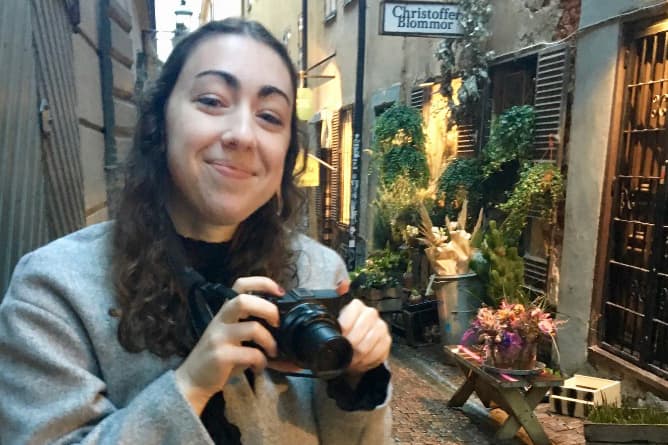My 21-year-old sister, Janna McPartland, has a lot on her mind.
Graduating from college. Finding a job. Dire predictions about global warming. The other day, I asked her how she was doing. “The planet is dying,” she said.
I was surprised, then, when she showed eagerness recently in starting to save for her retirement. I’d been nagging her to do that since I was hired as a personal finance writer at CNBC. My reporting has taught me a simple but powerful lesson: The earlier one starts saving, the easier it is to do.
It’s not just my professional experience that made me a nag. I’ve seen my mother, now in her late 60s, suffer the consequences of not saving. It’s a painful reality. I don’t want to see anyone else I love go through it.
Janna McPartland
Source: Janna McPartland
As a senior in college, Janna didn’t even know she was eligible to open a retirement account. “I never really thought about the possibility of saving now at 21,” she said. The average young person today doesn’t expect to start saving for retirement until 37. “I’ve never discussed retirement with my friends,” Janna said.
Experts say people could need $1 million — or more — to carry them through their post-working years, but the median family’s net worth clocks in at just around $15,000.
After I showed Janna some simple math about the benefits of starting to save now, she was ready to do it.
Here are the numbers:
If Janna starts saving $200 a month at 21, she’ll have $570,000 at 65 (assuming an annual return of 6.5%).
If she waited until 25 to start this routine, she’d have $435,000.
And if she waited until 37? $180,000.
“Time is the greatest money-making asset an individual can possess,” said Ed Slott, a retirement savings expert. That’s because of compound interest: The money you invest racks up interest, and that interest racks up interest, too.
CNBC’s Annie Nova, right, and her sister Janna eating donuts.
Source: Annie Nova
This month, Janna and I went to Fidelity and opened a type of individual retirement savings account for her called a Roth IRA.
Never heard of it?
It’s an investment account that allows your money to grow tax-free. You deposit money that you’ve already paid taxes on, and when you take out the money, you don’t have to pay any more taxes. “Tax-free compounding over time is very powerful and younger people have more time to take advantage of this,” Slott said.
There’s another reason we went with a Roth IRA. Unlike a traditional IRA, Janna can withdraw any money she has contributed to this account at any point without facing penalties. That freedom is why some people use Roths for their emergency savings. “If you think you might need to tap into the money but you want to start being serious and try not to, it’s a great vehicle to consider,” said Maura Cassidy, vice president of retirement at Fidelity.
Self-care is a hot, trendy subject right now, and for most people that means making a cup of tea or doing a sheet mask. But creating a safety net for myself, that feels like true self-care.
Janna McPartland
Our experience at Fidelity went smoothly — we were in and out in under 20 minutes. However, there was one hiccup: The branch representative told us that you can’t use a Roth IRA if you earn more than $77,000 a year. That’s wrong. Although there are income limits, they’re much higher. It’s a good reminder that you should fact-check everything you’re told by any person giving you advice about your money.
“Where is my money going exactly?” Janna asked.
“Hopefully up!” I said.
We decided to put her savings in a “target-date fund.” That simply means her asset allocation will adjust to reflect her age. It will begin more heavily invested in stocks, which are more risky but typically produce higher returns. When she’s in her 50s, her account will be made up of more bonds, which grow at a slower pace but hopefully will protect her money from big market drops.
More from Invest in You:
Here’s how to invest like Warren Buffett
Tips from people who didn’t save till their 40s or 50s
You’ll probably regret that timeshare, car payment
Janna thought she had to be working full time to start saving for retirement. That’s not the case with a Roth IRA. You just can’t contribute an amount beyond what you’ve earned for that year (or $6,000, the annual limit for 2019). So if between Janna’s two part-time jobs— babysitting and video editing — she earned $5,000 this year, that’s the most she’d be able to save in the account. (She plans to set up an automatic monthly deposit of $200.)
As we walked away from the bank, Janna said she felt less nervous for the future. Then she broke out into full Gen Z mode.
“Self-care is a hot, trendy subject right now, and for most people that means making a cup of tea or doing a sheet mask,” she said. “But creating a safety net for myself, that feels like true self-care.”
CHECK OUT: Grocery chain CEO who ate expired food for a year says ignoring some sell-by dates can save you ‘a ton of money’ via Grow with Acorns+CNBC.
Disclosure: NBCUniversal and Comcast Ventures are investors in Acorns.
